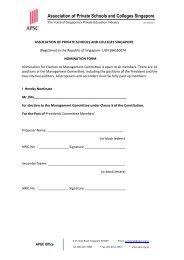A New Dynamic: Private Higher Education
A New Dynamic: Private Higher Education
A New Dynamic: Private Higher Education
- No tags were found...
You also want an ePaper? Increase the reach of your titles
YUMPU automatically turns print PDFs into web optimized ePapers that Google loves.
Financial consideration2with pump-priming support at the outset after which it should be regarded as anormal commercial activity?In this chapter we use a broad definition of private sector involvement with regard tofinancial involvement in tertiary education and not only include tuition fees, but alsoprivate support for research (either due to foundations or due to contracts andcommissions), income generated by institutions (patents, spin-off companies andconsultancies) and philanthropic donations.Whose perspective?It is instructive to look at the advent of the private sector from the perspectives ofthe key stakeholders, as each of them will have different views particularly as regardsthe financial impact.Governments' attitudes have been referred to above, but their concerns are not allrelated to finance. While they may welcome the willingness of the private providersto enrol students, who would otherwise have been unable to study in their homecountry, there are some innate concerns. By definition, the private providers will findit hard to meet any policy criteria of equity and easy access. Their fees will usually notbe affordable by all levels of society and their geographical focus on centres ofpopulation (usually the capital city) means that any rural students would find it hardto enrol since the institutions usually lack the space or the finance to provide hostelaccommodation. In addition, the disciplines commonly offered by most privateinstitutions are those favoured by the market where location in a large city is also apositive factor.Governments often face a conflict with regard to their pleasure at the private sector'srole and the implications of it for any national policies of equitable access to highereducation. The problem is that there is not a great deal that government can do tocorrect the obvious failings. They cannot instruct the private sector to enrol studentswho are unable to pay the fees or to locate their campuses in rural provinces, nor isit easy to enforce any quotas on students from poorer areas or castes (although thisis what draft Indian legislation would like to do). 3 <strong>Private</strong> providers cannot be directedto offer degrees in engineering or science, as the power of government only extendsto approving applications put forward and not initiating them. 4 Thus, as we shall see,the role of government is limited to providing incentives to entrepreneurs to bring3 See the draft Indian law to regulate private higher education, 2005.4 One way round this dilemma is by a public-private partnership in which the state contracts with aprivate provider to deliver certain programmes. The new university in Botswana is an excellentexample.31












